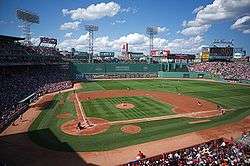Harvard Stadium
Harvard Stadium is a U-shaped college football stadium in the northeast United States, located in the Allston neighborhood of Boston, Massachusetts. The stadium is owned and operated by Harvard University and is home to the Harvard Crimson football program. The stadium's seating capacity is 30,323.[5]
Aerial view from the south in 2015 | |
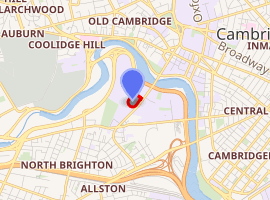
| |
| Location | 95 N. Harvard Street Boston, Massachusetts, U.S. |
|---|---|
| Owner | Harvard University |
| Operator | Harvard University |
| Capacity | 30,323 (1952–present) 57,166 (1929–1951) 42,000 (1904–1928) 20,000 (1903)[1] |
| Surface | FieldTurf (2006–present) Natural grass (1903–2005)[2] |
| Construction | |
| Broke ground | July 1903 |
| Opened | November 14, 1903 117 years ago |
| Construction cost | $310,000 ($8.82 million in 2019[3]) |
| Architect | Prof. Louis J. Johnson, Class of 1887 |
| Tenants | |
| Harvard Crimson (NCAA) (1903–present) Boston Patriots (NFL) (1970) Boston Cannons (MLL) (2007–2014, 2016–2018) Boston Breakers (WPS/NWSL) (2009–2011, 2014) Boston Brawlers (FXFL) (2014) | |
Harvard Stadium | |
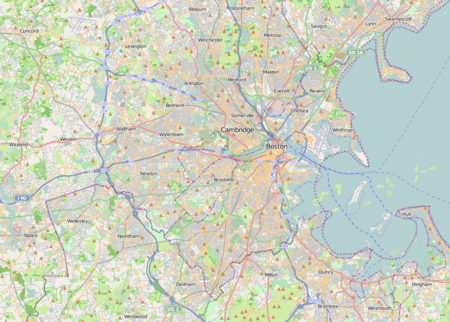   | |
| Location | 60 N. Harvard St., Boston, Massachusetts |
|---|---|
| Coordinates | 42°21′59″N 71°7′38″W |
| Area | 11 acres (4.5 ha) |
| Built | 1903 |
| Architect | McKim, Charles F.; Et al. |
| Architectural style | Classical Revival |
| NRHP reference No. | 87000757[4] |
| Added to NRHP | February 27, 1987 |
Built in 1903, it was a pioneering execution of reinforced concrete in the construction of large structures. Because of its early importance in these areas, and its influence on the design of later stadiums, it was designated a National Historic Landmark in 1987.[6] The stadium is the nation's oldest permanent concrete structure dedicated to intercollegiate athletics. It seated up to 57,166 in the past, as permanent steel stands (completing a straight-sided oval)[7] were installed in the stadium's northeast end zone in 1929. They were torn down after the 1951 season, due to deterioration and reduced attendance. Afterward, there were smaller temporary steel bleachers across the stadium's open end until the building of the Murr Center (which is topped by the new scoreboard) in 1998.
Harvard Stadium hosted one Boston Patriots season in 1970. It was their first season in the NFL after the AFL–NFL merger and their last before becoming the New England Patriots. The team moved to Schaefer Stadium in Foxborough the following season.
History
Harvard Stadium was constructed on 31 acres (13 ha) of land known as Soldiers Field, donated to Harvard University by Henry Lee Higginson in 1890 as a memorial to Harvard men who had died in the Civil War (1861–1865).[8] The structure, similar in shape to the Panathenaic Stadium, was completed in just 4½ months costing $310,000. Much of the funds raised came from a 25th reunion gift by Harvard's Class of 1879. It is the home of Harvard's football team. The stadium also hosted the Crimson track and field teams until 1984 and was the home of the Boston Patriots during the 1970 season, until Schaefer Stadium opened the following year to fulfill post-AFL–NFL merger minimum seating requirements requiring a 50,000+ seat venue.
Lewis Jerome Johnson, professor of civil engineering at Harvard, was a consultant to the design team for the stadium. It is historically significant that this stadium represents the first vertical concrete structure to employ reinforced structural concrete. Prior to the erection of the stadium in 1902, reinforced structural concrete was used in horizontal, that is flooring, sidewalks, etc., design only. Prof. Johnson was the engineer of note responsible for incorporating the concept into the vertical structure of the stadium design. There is a plaque dedicating the stadium to his honor on the east end wall outside the stadium.
Harvard installed both FieldTurf and lights in 2006.[9] In 2007, Harvard played its first night game at the stadium, winning 24–17 over Brown University on September 22.[10][11]
Impact on American Football
In the early 20th century, American football was an extremely violent sport. 18 players died and 159 were seriously injured in 1905 alone.[12] There was a widespread movement to outlaw the game but U.S. President Theodore Roosevelt intervened and demanded the rules of the game be reformed. In 1906, Roosevelt met with representatives from 62 colleges and universities and formed the Intercollegiate Football Conference, the predecessor of the NCAA.[13] The committee's purpose was to develop a uniform set of rules and regulations to make the game safer. A leading proposal, at the time, was widening the field to allow more running room and reduce serious collisions. While it was popular among committee members, Harvard objected. Their recently completed stadium could not accommodate a larger field. Because of the permanent nature of Harvard Stadium, the proposal was rejected and the forward pass was legalized in April 1906.[14] Harvard Stadium led to the creation of two of the most fundamental aspects of modern American football: standard field dimensions and the legal forward pass.
Other events
Early in its existence two ice rinks were built on the stadium during the winter months for the men's ice hockey team. The Stadium served as the home for the hockey team until World War I.[15]
Harvard Stadium was the site of the U.S. Olympic Trials for men's track and field in 1920, 1924, and 1928.
It is also the host of music festivals like the Amandla Festival, where Jamaican reggae legend Bob Marley performed a historic concert in 1979. Janis Joplin performed her last show at the stadium in 1970, shortly before her death. During the 1984 Summer Olympics held in Los Angeles, the stadium hosted several soccer preliminaries.[16] In 2007, the Boston Cannons, a professional lacrosse team for Major League Lacrosse, moved their home site to the stadium. They previously played at Boston University's Nickerson Field. They have since moved to Quincy, MA. [17]
Harvard installed FieldTurf and lights in 2006.
Beginning on April 11, 2009, Harvard Stadium became the home field of the Boston Breakers of the Women's Professional Soccer (WPS) league when they beat Saint Louis Athletica 2–0.
Harvard and the Boston Bruins have begun talks about making a bid for the stadium to serve as the host of the National Hockey League's 2024 NHL Winter Classic to coincide with the Boston Bruins' 100th anniversary year. If awarded the game, the Boston Bruins are expected to ask the NHL to have the Montreal Canadiens serve as the opposition.
1984 Summer Olympics
Association football games played at Harvard Stadium during the 1984 Summer Olympics
| Date | Time (EDT) | Team #1 | Result | Team #2 | Round | Attendance |
|---|---|---|---|---|---|---|
| July 29 | 19.30 | 0–0 | Group A | 25,000 | ||
| July 30 | 19.30 | 1–1 | Group B | 16,730 | ||
| July 31 | 19.00 | 1–2 | Group A | 27,832 | ||
| August 1 | 19.00 | 1–0 | Group B | 20,000 | ||
| August 2 | 19.00 | 0–2 | Group A | 17,529 | ||
| August 3 | 19.00 | 1–3 | Group B | 27,261 |
Location
Although most of Harvard's campus is in Cambridge, the stadium and most other intercollegiate athletic facilities, along with Harvard Business School, lie to the south, across the Charles River, in the nearby Allston neighborhood of Boston. The stadium is the most iconic piece of the Soldiers Field athletic complex, which also includes the baseball stadium, outdoor track, an artificial turf field hockey/lacrosse field, two soccer stadiums, pools, Beren Tennis Center (outdoor), the Gordon Indoor Track, Dillon Fieldhouse, Lavietes Pavilion, and Bright Hockey Center. Newell Boathouse, home of Harvard's men's crew, lies across Soldiers Field Road on the banks of the Charles.
The stadium's horseshoe opens to the northeast, towards the river, and the press box is at the top of the northwest sideline's grandstand. The running track has been removed; it was non-standard, with long straights and tight turns, and the outside lanes were very near the stadium walls.
Gallery
 Dedication Plaque by the Class of 1879–1903
Dedication Plaque by the Class of 1879–1903 50th Anniversary Plaque – 1953
50th Anniversary Plaque – 1953 Under construction (1903)
Under construction (1903) Harvard-Yale game of 1905
Harvard-Yale game of 1905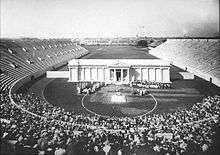 Performance of Greek Play – 1905
Performance of Greek Play – 1905.jpg) Hockey was played in Harvard Stadium until World War I
Hockey was played in Harvard Stadium until World War I Harvard-Yale game of 1911
Harvard-Yale game of 1911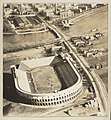 Aerial view with trapezoidal temporary wooden stands in place circa 1915–1928
Aerial view with trapezoidal temporary wooden stands in place circa 1915–1928.jpg) Scoreboard – 1984–2007
Scoreboard – 1984–2007 Exterior ivy, removed in 2006
Exterior ivy, removed in 2006 Aerial view of the 2006 Harvard-Yale game – the Murr Center (built in 1998) now sits across the open end of the stadium.
Aerial view of the 2006 Harvard-Yale game – the Murr Center (built in 1998) now sits across the open end of the stadium. Scoreboard – 2008–present
Scoreboard – 2008–present The stadium's southwest-facing exterior.
The stadium's southwest-facing exterior. View from the southern end of the colonnade. The Murr Center, an indoor recreation facility built in 1998, is the building at the end of the stadium.
View from the southern end of the colonnade. The Murr Center, an indoor recreation facility built in 1998, is the building at the end of the stadium. 2008
2008 2008
2008 Cheerleaders in Harvard Stadium, 2019
Cheerleaders in Harvard Stadium, 2019
See also
- Harvard Crimson
- List of NCAA Division I FCS football stadiums
- List of National Historic Landmarks in Massachusetts
- National Register of Historic Places listings in northern Boston, Massachusetts
References
- "Harvard Stadium Football History". Harvard University. Retrieved April 11, 2016.
- Lisa Kennelly, Extreme Makeover: Harvard Stadium, Harvard Crimson April 13, 2006.
- Federal Reserve Bank of Minneapolis. "Consumer Price Index (estimate) 1800–". Retrieved January 1, 2020.
- "National Register Information System". National Register of Historic Places. National Park Service. March 13, 2009.
- "Harvard". Harvard.
- "NRHP nomination for Harvard Stadium". Commonwealth of Massachusetts. Retrieved 2014-06-02.
- "Aerial view of Harvard Stadium". Digital Commonwealth. Newton, Massachusetts). 1930. Retrieved December 1, 2017.
- Harvard University (1949). "Memorial Hall". Education, bricks and mortar: Harvard buildings and their contribution to the advancement of learning. p. 82n.
- "Harvard Stadium". Boston Cannons. Retrieved April 24, 2016.
- "Harvard 24, Brown 17". ESPN. Associated Press. September 22, 2007. Retrieved December 1, 2017.
- Glenn, Malcolm A. (September 23, 2007). "Football topples Brown in historic night game". Harvard Crimson. (Cambridge, Massachusetts). Retrieved December 1, 2017.
- "First and 100". The Harvard Magazine. Retrieved April 12, 2016.
- "The 1905 Movement to Reform Football". Library of Congress document. Retrieved April 12, 2016.
- "Saturday Night Lights: Harvard Stadium Joins the 21st Century". New York Times. Retrieved April 12, 2016.
- "Timeline of Tradition" (PDF). Harvard Crimson. Retrieved January 6, 2020.
- 1984 Summer Olympics official report. Volume 1. Part 1. pp. 129-31.
- Malcom A. Glenn, Improved Stadium Scores Pro Team, Harvard Crimson, February 23, 2007.
External links
- Harvard University Athletics – Harvard Stadium
- Photos: , ,
| Events and tenants | ||
|---|---|---|
| Preceded by Alumni Stadium |
Home of the Boston Patriots 1970 |
Succeeded by Foxboro Stadium |
| Preceded by Nickerson Field |
Home of the Boston Cannons 2007–2018 |
Succeeded by Veterans Memorial Stadium (Quincy) |




